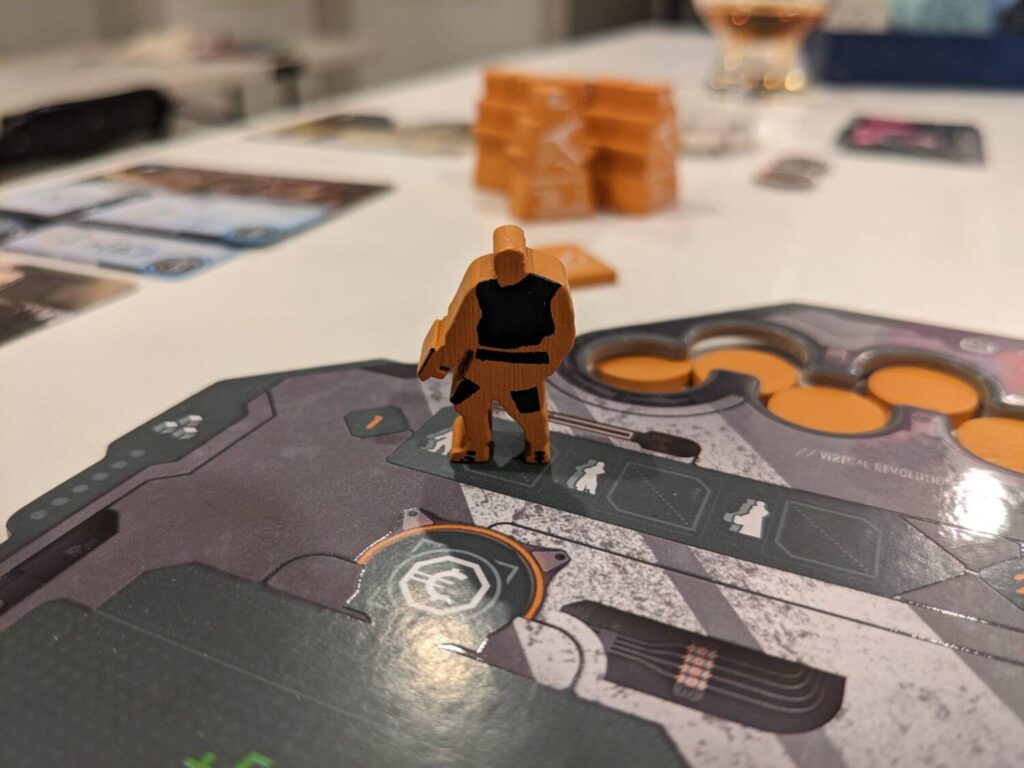I picked up a copy of Virtual Revolution (2023, Studio H) during Gen Con 2023, but this one sat on the shelf for a bit. Despite the cool cover and the fact that publisher Studio H has never done me wrong, buzz was quiet on this game so I worked through my SPIEL haul during most of the fall season.
In December, I got Virtual Revolution to the table. I first decided to investigate the source material. The game Virtual Revolution is based on a 2016 film titled 2047 Virtual Revolution. Thanks to Amazon Prime, I spent 90 minutes watching the film to get ready for the game.
The movie was…OK. The best part of the movie is the premise: in the near future, almost everyone is living out their life in a virtual world featuring “Verses” where people play out their fantasies serving as in-game avatars in medieval and sci-fi environments. So many people are living in Second Life-style worlds that the streets of “Neo Paris” are essentially dead. When the movie’s lead character, an agent named Nash (Canadian stuntman Mike Dopud), walks the streets, it looks like Neo Paris is completely deserted…because everyone is essentially playing video games.
The film’s references to so many other works are straightforward. Nash has the look and feel of a character from Blade Runner, and the film’s sets and neon signs reminded me of both Blade Runner and the sequel, Blade Runner 2049. Worlds like the one from Ready Player One (both the book and the Steven Spielberg film adaptation) also influenced 2047 Virtual Revolution, so as a sci-fi nut, I enjoyed the world of 2047 Virtual Revolution much more than the movie.
I was curious to see how much of the film would get featured in the board game because both the film and the game were directed/designed by Guy-Roger Duvert. I’m pretty sure I’ve never played a board game designed by a film director, so I expected the world-building to be on point.
That is mostly true. The production here outshines the gameplay and Virtual Revolution has a handsome table presence when each game is wrapping up. The game could use some sharper elbows and it misses an opportunity to really engrain the player into its world.

Yes, It’s a Game About Building Servers
Virtual Revolution is an area control game for 2-4 players, taking place over 15 turns across five rounds. Players take on the role of corporate management, in charge of a firm responsible for building virtual worlds that will absorb the lives of human beings bent on spending all of their time online.
Players will place their Directors (meeples) on the Neo Paris map, a map split into the roughly 20 different boroughs/neighborhoods of present-day Paris. Virtual Revolution features area majority scoring at the end of the game, as well as powers for the player who owns individual regions that break some of the game’s rules.
Individual turns become interesting thanks to a single element: Corruption.
Each turn, players select one of their three Directors—one looks like it is a brute holding a gun; another looks like a businessperson holding a briefcase, and the third looks like the woman who served as Nash’s handler in the film—to place in any of the boroughs in Neo Paris. Sadly, Directors don’t have any specific power or difference in placement abilities. The brute-looking token can set up a server just like the handler can. A surprising design choice; why didn’t the game just give us three red meeples that look the same?
I think this choice was made because the Director meeples just look really cool. After Directors are placed, players have an option to add, remove, or relocate Influence discs around the map to dictate area control. Most of these Influence actions will add Corruption cards to the active player’s hand. Corruption is situationally bad. All of the effects on Corruption cards typically remove items previously placed on the map or to a player’s board, or cost Eurocredits at the end of a round.
However, Corruption is only bad if it triggers a raid from your friends at Interpol.

Any player holding five or more Corruption cards at the end of a round gets raided and has to resolve ALL of their Corruption cards. So, the tension around taking a fourth or a fifth Corruption card ends up being the best part of the turn-to-turn structure of Virtual Revolution, although that tension deteriorates if players have Corruption cards that can’t affect them because they don’t have an Agent of the listed type or don’t have any servers in certain boroughs.
After deciding whether to take on a little more Corruption by increasing their faction’s Neo Paris Influence on the map, players take one of five actions, such as getting a small cash infusion, making a “donation” (to dump some of your Corruption cards) or hiring Agents to do the corporation’s dirty work. It’s fun to hire Agents; each Agent costs four Eurocredits and provides a once-per-round, exhaustible power and can later be retired to score end-game points and/or provide an in-game boost to other actions. Agents also provide an opportunity for light “take that” play with powers that can be used to rob other players of valuable resources.
The two actions that end up being the most consequential to end-game scoring: building servers and creating “Verses”, online worlds that are created by corporations. Both actions increase faction income. Both also come with more of that sweet, sweet Corruption in the form of more cards. And both actions are expensive—seven Eurocredits to create a Verse and 10 Eurocredits to build a server—but can score a lot of end-game points if they become a focal point. In my plays, players will find themselves doing both of these actions but will likely focus more on one action than the other.
Losing control of a borough during later turns isn’t the worst thing in the world. Influence discs that are kicked out go into the Recycle Zone, and as a free action, players can take any number of discs from the Recycle Zone back to their player board to get cash, Immunity tokens—which protect against the negative effects of a raid—or a quick peek at the end of round effects that will hit all players.
After five rounds (three turns per round) wrap up, players score across nearly ten categories, such as servers on the map, scoring conditions on Verse cards, total Agents, sets of Agent types, Objective cards, District ownership, and a few other areas. That turns Virtual Revolution into a bit of a “point salad” because you will find that players will score a lot of points in a lot of different areas. It is challenging to not score 150+ points during play.

The Look and Feel
As a production, Virtual Revolution knocks it out of the park.
That starts with the graphic design and iconography. Virtual Revolution’s player boards double as fantastic player aids. I used the boards to teach the game each time and I was surprised how few questions came from that initial teach, paired with the icons on the back of the rulebook to remind players of what everything does. The rulebook pushes its iconography hard as well.
The server tokens look slick. If only real-life servers looked this good! I’ve mentioned the Director tokens; while I wish each one represented something different to do, the meeples look good. The map of Neo Paris starts out pretty bland but gets colorful quickly, particularly in four-player games. The board’s layout with Agent card markets, available Verses, and the income track all stand apart nicely.
My only quibble with the production is the Influence disc holders at the top of each player’s mat. It is a little hard to get the discs out of the mat on a flat table, and getting them out usually shifts the entire player board so that any boost cards tucked underneath move too. It looks good but in practice this is not very effective. I stopped using that disc area after my first game, and now I just leave them in a pile near my other resources.
The card art is also interesting, featuring characters from the movie and a few Agents I didn’t recognize. The Verse card pictures evoke the kinds of imagery you would expect from the cyberpunk angle Virtual Revolution takes to detail its world. Along with all of this plus the box cover, Virtual Revolution’s look and feel are fantastic.

As a Game…
Virtual Revolution is interesting, but I wish the gameplay matched the stellar package surrounding it.
The gameplay is passable, and goals quickly become predictable. It is already becoming clear that focusing on either creating Verses or building servers, collecting sets of Agents, and concentrating on holding 2-3 areas of the map (ideally the ones with the best borough control cards) is what I’m going to do every game. If these goals line up with one of the two Objective cards you get to begin the game, you are probably in the driver’s seat to victory.
In some ways, I like that the District bonuses known as Titles are distinctly different. But four of them are outright better than the other three. (In my experience, the bonuses from ND and MA are the best, with PI and QL right behind them.) I always want to know what the end-of-round event card is going to affect, particularly if I am leading on the income track. I’m always going to want to take two Corruption cards so that I have more options to consider as I clear Corruption cards that are bad for me out of my hand. It is fantastic to activate an Agent for its exhaustible power, then set it upright to exhaust it again in the same round.
The Districts with terrible benefits are not interesting places to control! The CE District’s benefit is still not clear to me: you can remove a server to get your 10 Eurocredits back. The other power there allows you to dump a Verse card for 10 Eurocredits, which is a small profit over the seven Eurocredits you might have paid for it…but if you bought the right Verse cards in the first place, you’ll want those for the end-game points. This benefit ends up being anything but that.

Thoughts continue like this with Virtual Revolution across most elements—”two steps forward, one step back.” I love the quick turn structure. The game gives you an out whenever you need money in the form of the Work action, which could be boosted in a way that makes it really meaningful. But I wish there was more variety in the once-per-round Agent powers, which are split evenly between getting three Eurocredits, removing a disc from the map, or gaining an Immunity token.
I really love that I get to keep the two Objective cards drawn during setup, then play the entire game before being forced to decide which one I can try to score. I like that I can pay to wipe the current market of Verse cards. But, the other card market in the game, the Agent market? I can’t pay to wipe that.
There’s plenty to like about Virtual Revolution, and the game extends our positive thoughts on other Studio H productions like Vivarium, Oriflamme, the Suspects games, and the Northgard games. And if you are a fan of the film 2047 Virtual Revolution, not only is there this board game, there’s also a novel that serves as a prequel to the film. Who knew that 2047 Virtual Revolution would turn into such a massive property??












Add Comment